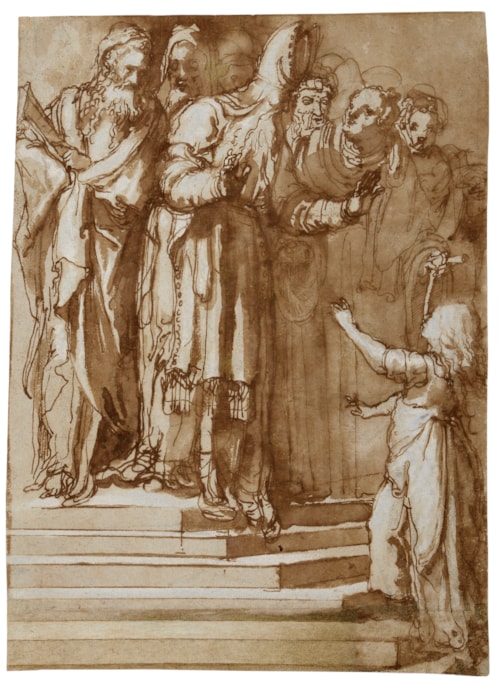
Niccolò Martinelli, TROMETTA
Pesaro c.1540 - Rome 1611
Biography
According to his biographer Giovanni Baglione, Niccolò Martinelli, known as Trometta, arrived in Rome from his native Pesaro as a youth and studied with 'il Zuccheri', almost certainly Taddeo Zuccaro. He remained profoundly affected by the example of the elder Zuccaro throughout his career, although he never seems to have matched his success. In the early 1560s Trometta worked with Taddeo and Federico Zuccaro on the decoration of the Casino of Pius IV in the Vatican gardens. He was established as an independent artist by January 1565, when he signed a contract to decorate the chapel of Paolo de Castro in the Roman church of Santa Maria della Consolazione. Shortly thereafter he received the commission for what is regarded as his finest work ('l'opera migliore che egli mai colorisse', in the words of Baglione); the decoration of the vault of the choir of the Roman church of Santa Maria in Aracoeli on the Capitoline Hill, begun in late 1566 and completed within two years. Trometta also decorated two chapels in the same church, while later Roman commissions included the decoration of a chapel in San Omobono in 1584 and four rooms in the palazzo of Cardinal Cesi in 1585; both works were later destroyed.
Trometta worked in several other Roman churches, notably at Santi Apostoli, Santa Croce in Gerusalemme, Santa Maria della Consolazione, San Francesco a Ripa, Santa Maria della Pace and San Rocco. Apart from the Aracoeli vault frescoes and chapel decorations, as well as another chapel in the church of Santa Maria dell'Orto, painted between 1591 and 1595, and an Adoration of the Shepherds in San Giovanni in Laterano, very little of Trometta's Roman work survives. The artist also painted altarpieces for churches in his native Pesaro, one of which, a Madonna and Child with Saints, is today in the Szépmüvészeti Muzeum in Budapest, as well as some paintings for the Capuchin church in Frascati and a Last Supper painted in 1568 for the church of San Lorenzo in Tavullia, near Pesaro.
Trometta was almost completely unknown as a draughtsman until John Gere's seminal article in Master Drawings in 1963, where a number of drawings by the artist - in Munich, Darmstadt, the Louvre and elsewhere - were identified as preparatory studies for the Aracoeli frescoes. These in turn formed the nucleus of a small corpus of around forty drawings by Trometta assembled by Gere, while further drawings by the artist have since been identified in various public and private collections. The influence of Taddeo Zuccaro is clearly evident in Trometta's drawings, and a number of his studies have long born traditional attributions to one or other of the Zuccari. Characteristic of Trometta's draughtsmanship is a preference for blue paper, on which the artist drew with great assurance with pen and brown ink and wash, often with extensive white heightening.




